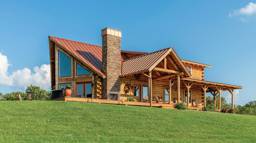
Matthew Beziat / Flickr
For some log home owners, carptenter bees, also known as boring bees, can be of great concern. Luckily, today's homeowners have a variety of methods, both new and old, to effectively rid their home of these pernicious pests. The even better news is there are many ways to prevent carpenter bees from taking up residence in your prized log home in the first place. Here's what you need to know.
Carpenter Bee 101
Where do carpenter bees live?
Carpenter bees live throughout the United States, though the western species of carpenter bees prefer to nest in oak, eucalyptus, and redwood. Eastern species will target pine, redwood, fir, and cedar.Do carpenter bees sting you?
Many people find themselves intimidated by these pests because of their sheer size and resemblance to bumble bees. (Bumble bees have thick yellow hair on the abdomen while the tail end of a carpenter bee is black and shiny.) Surprisingly, though, carpenter bees are not structurally or physically threatening (male carpenter bees have no stingers and females are usually docile).
What do carpenter bees do?
Female carpenter bees could teach carpentry classes with their precision and reuse of material. Beginning work each April and May, females use their strong jaws to drill holes into the surface of the wood. Once the entrance is complete, the females make a sharp 90-degree turn and begin tunneling. These tunnels will continue anywhere from 1 foot to 4 feet until the females stop to carve out a nest.
Carpenter bee nests are actually a series of small cells with walls made of chewed wood pulp in between. A female often creates six to 10 cells in a row along the main tunnel. At the end of this excavated gallery of cells she will leave a mixture of regurgitated nectar and pollen to feed her larvae. With her work complete, the female will die. The food ball is enough to keep the larvae fed through the growth cycle, around seven weeks.
Sometime in August, the new adult carpenter bees will venture from the nest, only to return for hibernation through winter. The following spring the new generation of carpenter bees begin the life cycle again. The females will recycle the old nests, with some modifications, for their own larvae, sometimes for years at a time. Fresh sawdust along with drips of pollen and waste make tunnel entrances easy to spot.

Photo: Wikimedia Commons
Carpenter Bee Prevention
According to Tew, there is no universally accepted, good way to control carpenter bees, there are, however, many prevention methods. Owners of log homes must be extra-vigilant from the beginning.
Coat the wood early
“It is best to coat the wood before the bees ‘find’ it because the next generation will return the following year to try again, and again, once the wood has been tunneled,” says Barbara Bloetscher, also an entomologist with Ohio State University.
While wood stains will not deter carpenter bees, any exterior finishes with oil or polyurethane bases will help. Each spring, start early, and plan on spraying the exterior of your log home with an insecticide.
Look for the right ingredients
If you decide to do the spraying yourself, look for insecticides with a pyrethroid as the active ingredient. This chemical is also known as bifenthrin, cyfluthrin, deltamethrin, and permethrin. Many pesticides can be purchased on the Internet in concentrated form.
Most exterminators, for example, use a product known as Demand CS as a deterrent to carpenter bees. Demand CS is a microencapsulated pyrethroid containing the active ingredient lambda-cyhalothrin. Demand CS can be purchased in concentrated form with each 8 oz. bottle making 40 gallons of solution. The price for one bottle runs around $60.
Some pesticides, like Demand CS, may require special licensing training or registration of the user in certain states. Make certain with your local extension agency, EPA office, or state list of registered pesticides before making any purchases. Some states will provide licenses and/or permits for personal use of registered pesticides for a nominal fee.

Photo: Wikimedia Commons
How to Get Rid of Carpenter Bees
What do you do if these bees have already turned your home into their home? First, take precaution. As mentioned earlier, female carpenter bees do have stingers and, although usually docile, could attack if provoked. Wait until it is dark out to treat the damanged wood, as the bees are less active then. Futhermore, be sure to wear some protective clothing.
Next, choose your strategy. Because the nests are vital to the bees year-round, destroying them gives you the best chance at extermination. There are a variety of options when it comes to extermination. Here are some pros and cons of different strategies:
Should you kill carpenter bees?
Choosing an insecticide for carpenter bees
In the past, Borax was used as a common insecticide for carpenter bees. The disadvantage with this method, however, is length of time it takes to kill the bees. Borax, pumped into the entrance holes, works slowly, giving the bees time to cause more damage.
“Borax is toxic to birds, bees and other wildlife,” cautions Bloetcher. “Although people refer to it as a ‘home remedy,’ when used improperly and allowed to blow and float in the air, it can be lethal to other vertebrates and invertebrates.”
Will wasp spray kill carpenter bees?
Be careful what you purchase, though, pesticides with stomach poisons are useless against carpenter bees because the bees don’t actually eat the wood. In addition, pesticides can degrade in a matter of weeks or months making a reapplication necessary during the summer if carpenter bees are spotted. For spot treatment, anything labeled effective against bees and wasps will also deter carpenter bees.
Closing the entrance
After using the insecticide, plug the hole with a wood dowel coated in carpenter’s glue, caulking, or putty.
“Simply caulking burrow entrances closed will not stop the problem,” explains Tew. “Carpenter bees can cut through caulking compounds.”

Photo by NY State IPM Program at Cornell University
How to Get Rid of Carpenter Bees Naturally
For those disinclined to the use of pesticides, there are some common-sense approaches to carpenter bee infestation. Some homeowners have found that waiting until winter to plug entrance holes with wood dowels to be most effective. Because the bees hibernate in the nests, they become trapped in spring when it’s time to emerge.
Strangely, these bees are less inclined to bore out of wood than they are into it. Others swear by the use of roofing nails, set in the entrance holes and covered with a caulking compound, this must be done in the fall after the new adults have left the nest, otherwise the bees will bore their way out. Taking a wire and inserting it far into the tunnels to destroy the nests is another alternative, although this requires the right timing and protective clothing to prevent stings.
“Carpenter bees are very discerning about the lumber they attack,” says Tew. “If only a single trim board is being attacked, replacing that board might solve the problem.” Finally, there is the option of doing nothing. “The control path of least resistance,” continues Tew, “is simply don’t try to control them. After the first few killing frosts, the bees will die. Patch the burrow entrances and hope the next season will produce fewer pest bees.”
For more information on carpenter bees, check out Ohio State University’s carpenter bee fact sheet.











